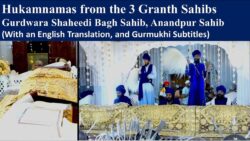In this video we see translations of Hukamnamas (aka “Mukhwaak” or “Guruvak”) being taken from the 3 Granths –
1. Adi Sri Guru Granth Sahib (0:00)
2. Sri Dasam Granth Sahib (3:17)
3. Sri Sarbloh Granth Sahib (5:37)
These Hukamnamas are taken by the Singhs of Tarna Dal Misl Shaheedan (a unit of the Nihangs) at the Chauni/Gurdwara Shaheedi Bagh Sahib in Anandpur Sahib, Punjab. A Hukamnama is first taken from Adi Guru Granth Sahib Ji (present at the center*). After that a Hukamnama is taken from Sri Dasam Granth Sahib (installed on the right*) and then finally from Sri Sarabloh Granth (installed on the left*).
* This is from the perspective of the Sangat, when seated and facing Guru Granth Sahib Ji in the Darbar.
Images of relevant manuscript folios are shown of each Granth Sahibs. Each of these manuscripts carries a date from the 1690s (Which is from within the lifetime of Guru Gobind Singh Ji). In “Sources for the Study of Guru Gobind Singh’s Life and Times”, Dr. Gurinder Singh Mann (University of California, Santa Barbara) describes how the Nihang Singhs,
“attribute both the Dasam Granth and Sri Sarab Loh Granth to Guru Gobind Singh. They place the Dasam Granth on the right and Sri Sarab Loh Granth on the left side of the Guru Granth in their public worship. The ceremonial texts of the Dasam Granth and Sri Sarab Loh Granth have 1428 and 1216 pages, respectively. Chatar Singh Jiwan Singh, a commercial publishing house based in Amritsar, prepares these texts for use in the gurdwaras associated with the Nihangs” (Mann, 2008, p. 279).
Dr. Mann also describes two 1698 CE manuscripts in his article (and provides two images of folios from these respective manuscripts). One manuscript starts with, “Bachitar Natak Granth (folios 1 to 350), and then goes on to include Sri Sarab Loh Granth (folios 351 to 702). The second manuscript contains only the text of Sri Sarab Loh Granth, though its pagination begins with folio number 351 and closes with 747” (Mann, 2008, p. 255).
The second manuscript described by Dr. Mann is the one shown in this video and has been digitized (and is accessible online).
